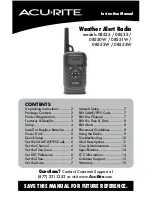
21
I
ndoor radio sensor without air pressure
The indoor radio sensor
without air pressure corresponds to the indoor sensor
with air pressure with regard to operation and function. However, it only contains
a temperature and humidity sensor, but no air pressure sensor. This sensor can
be freely addressed and assigned a name. The address can be defined as re-
quired according to the previous paragraph.
This sensor is well suited for use in indoor areas, such as a garage, cellar or
even attic, because it is battery operated and continues to function in the dark.
Indoor/Outdoor temperature sensor
The indoor/outdoor temperature sensor requires the insertion of 2 round cell bat-
teries in order to operate. The electronically remote, encapsulated temperature
sensor connected to a 4,95 ft long connection line enables it to measure the
temperature in garden ponds or ground areas, etc.
This sensor can also be freely addressed.
The splashproof electronics housing can be installed or set down at the required
location and the temperature sensor placed in or on the required object. The
sensor only supplies temperature data, not humidity data.
Outdoor radio sensor with solar power supply
The outdoor radio sensor enables the transmission of temperature and humidity
values related to the site of its installation.
This sensor can also be freely addressed. At the factory, all solar powered out-
door sensors are defined as Sensor 1. However, individual addressing is possi-
ble.
T
he sensor should be installed on the North or West side
because temperature
information in meteorological terms always relates to ‘shaded areas’
.
It can also
be installed at other sites, as required
.
It is only necessary to ensure that the
solar cell which provides the sensor with power is always exposed to light
.
The
sensor should not be located near obstacles, such as leaves, which cast shad-
ows and interfere with the power supply from the solar cell
.
A good installation site, for example, is underneath a roof overhang
.
The sensor is designed for installation on a mast or wall and should be mounted
as follows: Mount the sensor wall bracket either exactly vertical on a wall using
four screws or on a mast using the holding clamp
.
Insert the sensor in the wall bracket and screw the parts together using the screws
supplied
.
The protective cover should be at the top and the solar cell exposed to light
.
During periods of darkness or bad weather with little or no sunlight, power is
provided to the sensor by an internal, solar buffered, backup battery system
.
Содержание WS-2010
Страница 1: ...1 PC Radio Weather Station Operating and Evaluation Software for Windows 95 98 NT ...
Страница 7: ...7 Chapter 1 Introduction ...
Страница 14: ...14 ...
Страница 15: ...15 Chapter 2 Commissioning ...
Страница 24: ...24 ...
Страница 25: ...25 Chapter 3 File ...
Страница 31: ...31 Chapter 4 Display ...
Страница 36: ...36 ...
Страница 37: ...37 Chapter 5 Weather Display ...
Страница 39: ...39 Chapter 6 Interface ...
Страница 43: ...43 Chapter 7 View ...
Страница 47: ...47 Chapter 8 Windows ...
Страница 49: ...49 Chapter 9 Buttons ...
















































